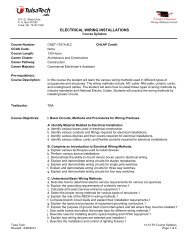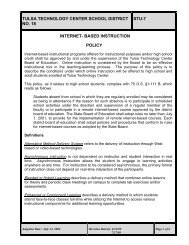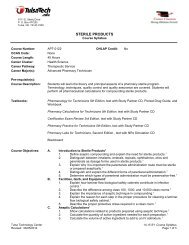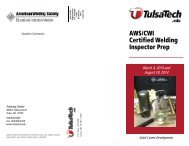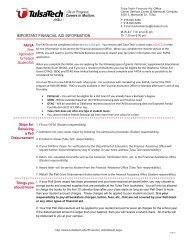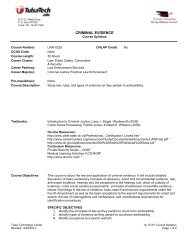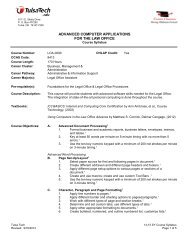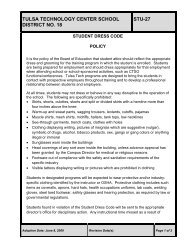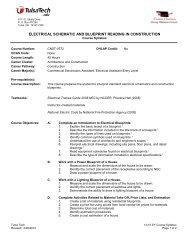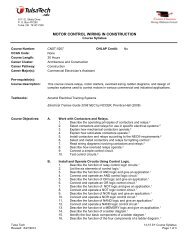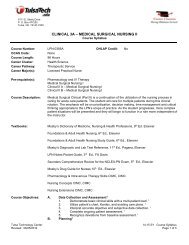Anatomy & Physiology I - Tulsa Technology Center
Anatomy & Physiology I - Tulsa Technology Center
Anatomy & Physiology I - Tulsa Technology Center
Create successful ePaper yourself
Turn your PDF publications into a flip-book with our unique Google optimized e-Paper software.
ANATOMY AND PHYSIOLOGY I<br />
of their uses in the body. 1<br />
7. Explain the importance of water and salts to body homeostasis. 1<br />
8. Distinguish between organic and inorganic compounds. 1<br />
9. Compare the structures and functions of carbohydrates, lipids, proteins and<br />
nucleic acids. 1<br />
10. Distinguish between different types of proteins. 1<br />
11. Describe how and where enzymes work in the body. 1<br />
12. Compare and contrast the structure and functions of DNA and RNA. 1<br />
13. Explain the role of ATP in cell metabolism. 1<br />
C. Cells and Tissues 1<br />
1. Identify on a cell model or diagram the cell organelles and be able to explain<br />
their functions. 1<br />
2. Describe the structure of the plasma membrane, and explain how the various.<br />
transport processes account for the directional movements of specific<br />
substances across the plasma membrane. 1<br />
3. Describe different cell types and explain the functionality of the differences. 1<br />
4. Describe the cell cycle, including the phases of mitosis, and explain how the<br />
timing of cell division is regulated. 1<br />
5. Have an understanding of stem cells and how they are used in modern<br />
medical procedures and research. 1<br />
6. Name the four primary classes of human tissues and explain how they differ<br />
structurally and functionally. 1<br />
7. Know the anatomical location of the different tissue types. 1<br />
8. Describe ways the body repairs damaged tissue. 1<br />
9. Identify the various forms of cancer and describe how it affects the body. 1<br />
D. Integumentary System 1<br />
1. Have an understanding of the functions of the skin and be able to relate them<br />
to its structure. 1<br />
2. Recognize and identify the major skin structures when provided a diagram or<br />
model. 1<br />
3. Identify and know the purpose of the accessory structures of the skin. 1<br />
4. Describe the normal and pathological colors that the skin can have and explain<br />
their causes. 1<br />
5. Identify and differentiate between the three types of skin cancer. 1<br />
6. Describe the three classes of burns and the priorities in burn treatment. 1<br />
7. Understand the role of the integumentary system in maintaining homeostasis. 1<br />
E. Skeletal System 1<br />
1. Identify the subdivisions of the skeleton as axial or appendicular. 1<br />
2. State several functions of the skeletal system. 1<br />
3. Demonstrate knowledge, with the use of models or pictures, the major bones,<br />
their surface features, and basic functions. 1<br />
4. Describe the developmental aspects of the skeleton from formation in the fetus<br />
throughout the lifetime of the bones. 1<br />
5. Distinguish between and give the function of the four major classes of joints. 1<br />
6. Be able to identify and understand the function of tendons and ligaments. 1<br />
7. Understand the causes and current medical treatments of skeletal disorders<br />
and abnormalities. 1<br />
F. Muscular System 1<br />
1. Distinguish between the three types of muscles, and tell where they are<br />
located in the body. 1<br />
2. Describe the structure of a skeletal muscle with respect to location and names<br />
of its connective tissue coverings and attachments. 1<br />
3. Describe the microscopic structure and functional role of the skeletal muscle<br />
fiber. 1<br />
<strong>Tulsa</strong> Tech<br />
14-15 SY Course Syllabus<br />
Revised: 8/19/2014 Page 2 of 4



